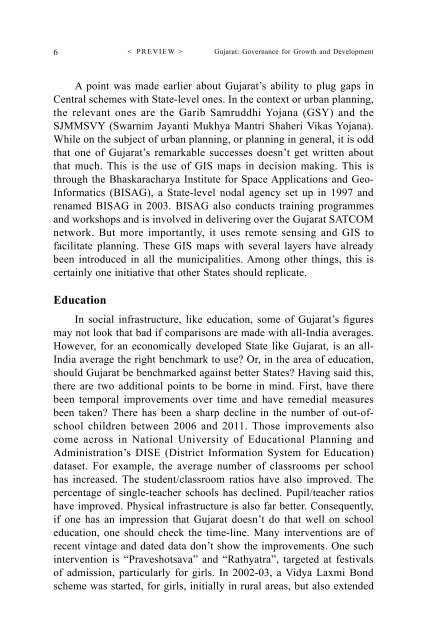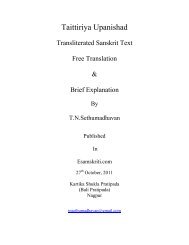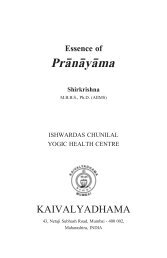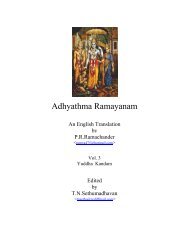Gujarat Governance for Growth and Development ... - Esamskriti.com
Gujarat Governance for Growth and Development ... - Esamskriti.com
Gujarat Governance for Growth and Development ... - Esamskriti.com
You also want an ePaper? Increase the reach of your titles
YUMPU automatically turns print PDFs into web optimized ePapers that Google loves.
6<br />
< PREVIEW > <strong>Gujarat</strong>: <strong>Governance</strong> <strong>for</strong> <strong>Growth</strong> <strong>and</strong> <strong>Development</strong><br />
A point was made earlier about <strong>Gujarat</strong>’s ability to plug gaps in<br />
Central schemes with State-level ones. In the context or urban planning,<br />
the relevant ones are the Garib Samruddhi Yojana (GSY) <strong>and</strong> the<br />
SJMMSVY (Swarnim Jayanti Mukhya Mantri Shaheri Vikas Yojana).<br />
While on the subject of urban planning, or planning in general, it is odd<br />
that one of <strong>Gujarat</strong>’s remarkable successes doesn’t get written about<br />
that much. This is the use of GIS maps in decision making. This is<br />
through the Bhaskaracharya Institute <strong>for</strong> Space Applications <strong>and</strong> Geo-<br />
In<strong>for</strong>matics (BISAG), a State-level nodal agency set up in 1997 <strong>and</strong><br />
renamed BISAG in 2003. BISAG also conducts training programmes<br />
<strong>and</strong> workshops <strong>and</strong> is involved in delivering over the <strong>Gujarat</strong> SATCOM<br />
network. But more importantly, it uses remote sensing <strong>and</strong> GIS to<br />
facilitate planning. These GIS maps with several layers have already<br />
been introduced in all the municipalities. Among other things, this is<br />
certainly one initiative that other States should replicate.<br />
Education<br />
In social infrastructure, like education, some of <strong>Gujarat</strong>’s figures<br />
may not look that bad if <strong>com</strong>parisons are made with all-India averages.<br />
However, <strong>for</strong> an economically developed State like <strong>Gujarat</strong>, is an all-<br />
India average the right benchmark to use? Or, in the area of education,<br />
should <strong>Gujarat</strong> be benchmarked against better States? Having said this,<br />
there are two additional points to be borne in mind. First, have there<br />
been temporal improvements over time <strong>and</strong> have remedial measures<br />
been taken? There has been a sharp decline in the number of out-ofschool<br />
children between 2006 <strong>and</strong> 2011. Those improvements also<br />
<strong>com</strong>e across in National University of Educational Planning <strong>and</strong><br />
Administration’s DISE (District In<strong>for</strong>mation System <strong>for</strong> Education)<br />
dataset. For example, the average number of classrooms per school<br />
has increased. The student/classroom ratios have also improved. The<br />
percentage of single-teacher schools has declined. Pupil/teacher ratios<br />
have improved. Physical infrastructure is also far better. Consequently,<br />
if one has an impression that <strong>Gujarat</strong> doesn’t do that well on school<br />
education, one should check the time-line. Many interventions are of<br />
recent vintage <strong>and</strong> dated data don’t show the improvements. One such<br />
intervention is “Praveshotsava” <strong>and</strong> “Rathyatra”, targeted at festivals<br />
of admission, particularly <strong>for</strong> girls. In 2002-03, a Vidya Laxmi Bond<br />
scheme was started, <strong>for</strong> girls, initially in rural areas, but also extended














